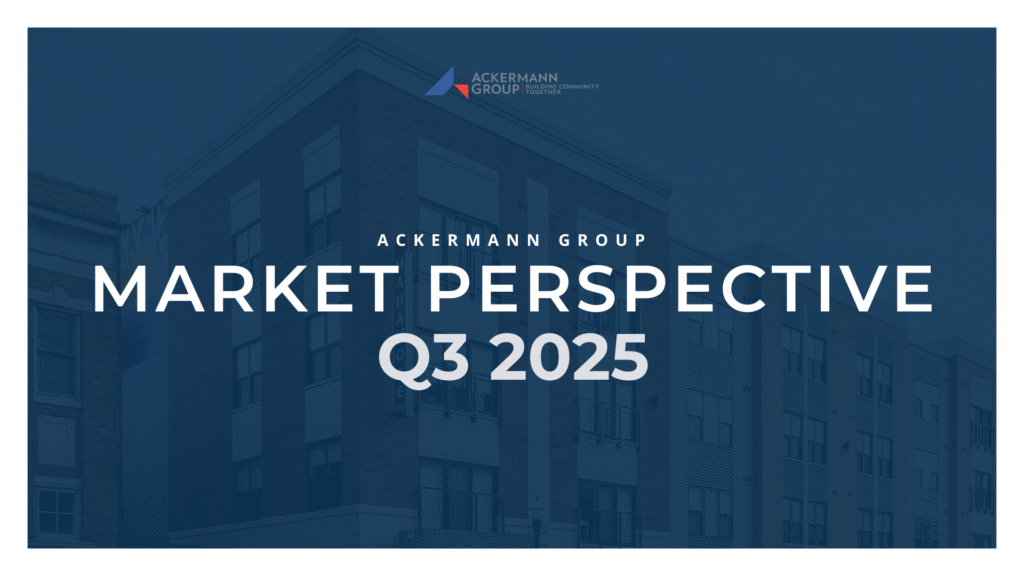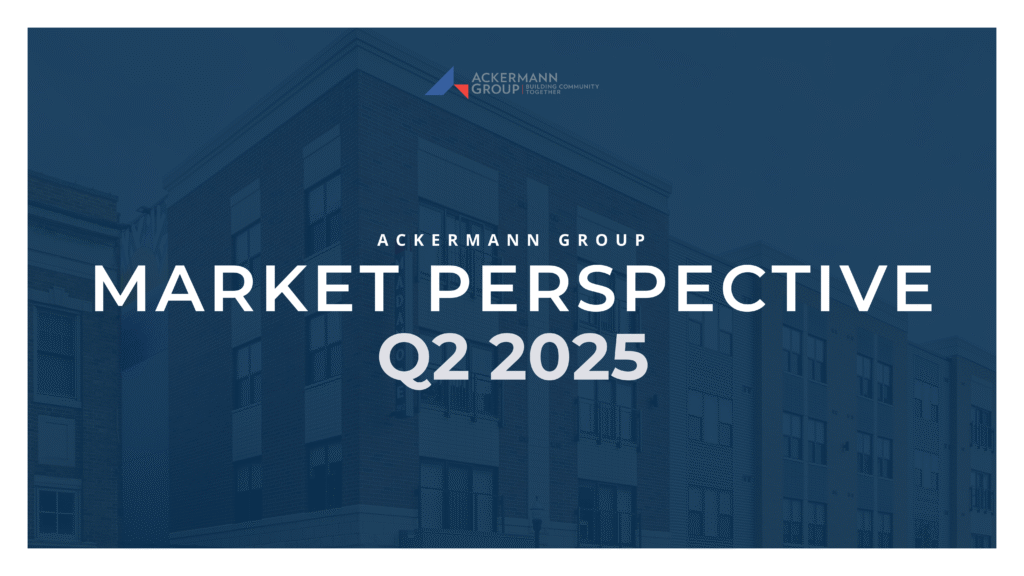U.S. Economic Overview
In the second quarter of 2025, the U.S. economy experienced a 3.0% annualized growth rate in real GDP. However, this growth largely overstates the underlying economic health, as net exports contributed a record 5.0 percentage points, primarily a mechanical effect of trade policy rather than genuine economic evolution. The unemployment rate in Q2 2025 was 4.2%. Looking ahead, the labor market is showing signs of softening, with July’s jobs report revealing significant downward revisions to previous months’ employment figures and a slowing pace of payroll growth. Consequently, the unemployment rate is projected to rise to 4.4% by year-end 2025.

National Apartment Market
In the second quarter the US Multifamily market saw measured improvements in all categories with regional disparities similar to previous quarters. Annual rent growth remained slow at 0.8%, below the record increases observed in late 2021 and early 2022, and below the 3.6% average from the five years prior to the pandemic. However, rent growth is accelerating with quarterly rent growth coming in at 1.1%. The chart below shows annual rent growth from 2020 – 2025 (Realpage Market Analytics).

Rent growth is most closely correlated with occupancy, and national occupancy continues to improve. The second quarter saw occupancy reach 95.7%, .03% higher than the 5-year average and 1.5% higher than the second quarter of 2024. Tightening occupancy is a good predictor of future rent growth. The chart below shows occupancy from 2020 – 2025 (Realpage Market Analytics).

In the second quarter of 2025, the U.S. national apartment market experienced remarkably strong demand, with 227,010 units absorbed, marking the strongest second quarter and second-highest quarterly demand on record (30+ years). Demand continues to outpace supply as the pace of new inventory slows drastically.
In the second quarter, 108,000 new apartment units were delivered. This is a 31% decrease from the peak quarterly deliveries in the third quarter of 2024 and the third consecutive quarter of declining new supply. Elevated interest rates combined with high construction costs make new development less attractive to merchant developers, which has led to slow new construction starts that will keep deliveries low through at least 2027. In fact, the estimated deliveries in calendar year 2027 is forecasted to be lower than any year since 2015. The chart below shows quarterly deliveries measured in units through the second quarter 2025 while also giving a forecast through 2027 (Realpage Market Analytics).

Ackermann Target Markets
Similarly to previous quarters, the Ackermann target markets continue to outperform the overall United States market and the regions in which they are located. This outperformance is based on continued strong demand against a backdrop of steady but not overwhelming supply growth. The graphic below compares forecasted rent growth in Ackermann Target markets against annual net inventory growth (new units in the past year measured against existing apartment units, a higher percentage means more new apartment units).


Generally, the markets with the highest net inventory growth have lower forecasted future rent growth. Columbus is an outlier in the fact that developers are building more apartments, but demand is strong enough to forecast stable rent growth over the next 3.5 years. In the South, Lexington continues to stand out as a strong performer with low inventory growth and nationwide leading rent growth (RealPage Q2 2025 – Annual Rent Change).
The stable market environment in the Midwest is beneficial both for current owners and investors looking for predicable returns. In the South, lower rent growth in the short term could present attractive entry points while strong demand catches up with historically elevated new supply. Regardless of region, the Ackermann strategy of targeting growing but under the radar secondary markets is proving prudent in the high supply cycle that the greater multifamily apartment market is currently moving past.
Capital Markets
Financing continues to be readily available for multifamily assets. However, with a slow sales market, financing activity is focused on refinances rather than a combination of both acquisition loans and refinances. The past 20 years, refinancing activity has averaged 53% of all multifamily loan origination, while in the past 12 months that percentage has increased to 65% (Newmark). Despite this, $153B of multifamily financing was completed in the first half of 2025, compared to $107B in the first half of 2024, a 43% increase.
Distress
The much anticipated “Wall of Maturities” is upon us and to this point it has generally been a non-story as borrowers and lenders agreed to extend loans into a potentially more favorable interest rate environment. As interest rates have remained persistently high, cracks are beginning to form and delinquencies are beginning to tick up.
At the end of Q1 2025, banks reported $9.39B of delinquent multifamily loans (defined as 30 days past due). While that number represents only 1.5% of all multifamily loans held by banks, the amount delinquent has increased 156% from Q1 2024. During the financial crisis, in Q1 2010 the banks reported the highest level of delinquent multifamily loans at $12.68B, representing 4.5% of outstanding bank multifamily debt. So while there is a long way to go from a percentage standpoint, the $9.39B in delinquent loans is the highest reported in 14 years (Q1 2011 – CredIQ).
Focusing on securitized multifamily loans, Newmark reports that $54.2B of outstanding securitized loans have a debt service coverage ratio (DSCR) of less than 1.25x, including $41.6B that is operating at a loss (DSCR < 1.0). Generally, these are floating rate loans, so any change in interest rates or operating environment could move these loans into default.
Fannie Mae borrowers aren’t immune to distress either. As of Q1 2025, .61% or $3.1B in loans are 60+ days past due. While this percentage is stable when compared to previous quarters, the number of properties that Fannie has foreclosed has skyrocketed. Fannie Mae currently reports 176 properties in its REO inventory (Real Estate Owned). These are properties that have been foreclosed on and transferred from delinquent borrowers to Fannie. The chart below from the Fannie Mae 2024 annual report highlights the increase in REO over time.

In the period directly after the financial crisis, Fannie’s real estate owned (REO) inventory peaked at 260 properties. At 176 properties currently, Fannie has reached 67% of the GFC peak (Fannie Mae 2Q 2025 Results). The above data clearly shows that distress is increasing, though it is unclear what this will mean for the multifamily market in the years ahead.
Investment Sales
The investment sales market remains muted. In the 1H 2025 multifamily apartments valued at $65B were sold to investors, this is a slight increase over the $61B that was sold in the first half of 2024. Since 2023, there have only been 2 individual quarters which sales have topped $40B – compared to the peak in Q4 2021 where over $160B of multifamily was traded. The below chart from CBRE compares quarterly multifamily sales since 2019 and overlays the associated sales cap rate. As borrowing rates stay elevated and stable, investment sales volume continues to be low.

Conclusions
The current conditions in the multifamily market are by no means straight forward. However, lower supply and strong demand point to solid future rent growth while increasing distress may lead to an increase in forced investment sales. While by no means a guarantee, it is possible that interest rate policy may change in 2026. If the cost of borrowing is lowered, multifamily values are likely to surge and cap rates could compress as investors see better rent growth combined with a lower cost of capital. It is our view that investments made in the next 12 months will be positioned to perform exceptionally well as both the operating and capital market conditions are poised to improve. It is very likely that this is the bottom of this real estate cycle and now is the optimal time to deploy capital.



